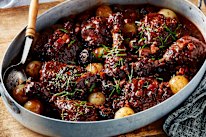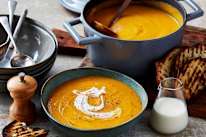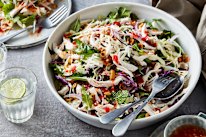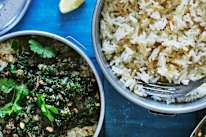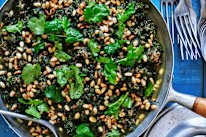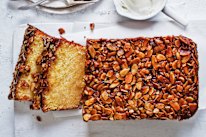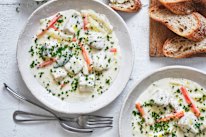Number one in Good Food’s countdown of 2023’s most popular cakes is revealed (and it’s citrussy good)
We counted down the 25 most popular cakes and bakes of the year, and this orange, almond and olive oil cake with yoghurt cream came out on top.
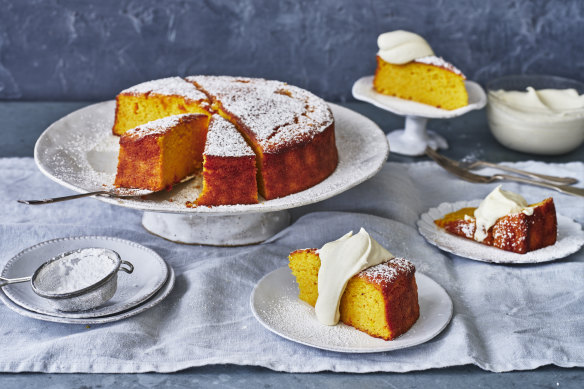
Orange cakes are having a moment, and by “moment” I mean a decade, if not more. Always moist, always delicious and easily adapted to gluten-free baking, there’s a reason orange cakes top the most-popular list on almost every recipe website. They’re the cake for the 21st century. Here’s why they’re so popular, and a necessary weapon in your culinary arsenal.
Ingredients
2 small oranges
4 eggs
250g sugar
150g almond meal
150g plain flour (or gluten-free flour)
1 tbsp baking powder
1 tsp salt flakes
150ml olive oil
Yoghurt cream
300ml thickened cream
150ml thick yoghurt
1 tsp vanilla paste
2 tbsp icing sugar mixture, plus extra to serve
Method
Step 1
Place the oranges in a medium saucepan and cover with cold water. Heat water until simmering, then simmer for 45 minutes. Drain and set aside oranges to cool. When cooled, roughly dice the oranges and remove the seeds. Place the remainder into a food processor or blender and blend to a smooth puree.
Step 2
Heat the oven to 170C conventional (150C fan-forced) and line a 22.5cm springform cake tin with baking paper. With a stand mixer or electric hand beaters fitted with the whisk attachment, whisk the eggs and sugar together until pale and foamy. In a separate bowl combine the almond meal, flour, baking powder and salt and combine with a dry whisk. Combine the egg mixture and orange puree. Using a spatula, fold the flour mixture into the wet mixture, then fold in the olive oil.
Step 3
Transfer the cake mixture to the prepared tin and bake for 1 hour, or until a skewer inserted in the centre comes out clean. Remove from the oven and allow the cake to cool in the tin for 15 minutes before removing to cool completely.
Step 4
When cool, whip the cream, yoghurt, vanilla and icing sugar together until rich and thick. Serve the cake dusted with icing sugar mixture with a big dollop of the yoghurt cream.
Tips
Fat versus foam
You can categorise almost all cakes into two broad categories – fat and foam.
Fat cakes use fats such as butter or oil to give them richness. In the case of butter, it can also be used to lighten the cake. If a recipe starts with “creaming” butter and sugar together, this is a vital step. Whipping the butter incorporates air, which will make your cake light and fluffy. Compare this with a dense pound cake (also a fat cake), where the butter is not whipped, giving it a much more dense texture.
Foam cakes, on the other hand, use air and liquid trapped within the foam of whipped eggs to give it lightness and moisture. Foam cakes such as angel food cakes, Victoria sponge and chiffon cake often use less oil than fat cakes and can sometimes be dry if too much flour is used or if it’s overcooked.
Orange cakes are a hybrid of the two styles. They use foam to give the cake lift, but also incorporate moisture and natural oils from whole oranges. My version also uses olive oil for added richness.
While traditional French baking mostly uses butter, Italian and Japanese recipes often use liquid oils (olive or vegetable), which, by virtue of being liquid at room temperature, can often be more easily incorporated into foam cakes, making the cake more moist.
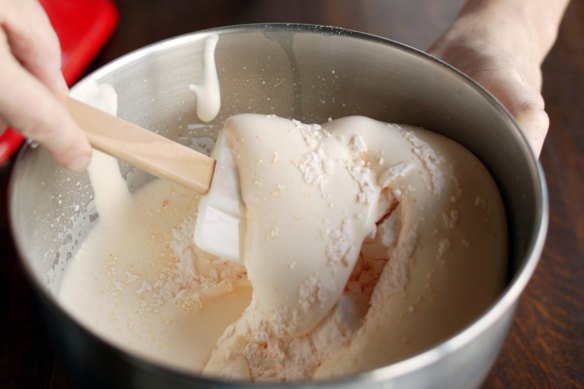
Mixing and folding
Whether you’re making a fat, foam or hybrid cake, combining dry ingredients with the wet is one of the most important skills in baking.
When combining flour into a fat or butter cake, overworking the flour is one of the most common errors. Too much mixing develops the gluten in the flour, which will make your cake tough and dense. Whip butter at high speed to incorporate air, but incorporate flour at low speed to that you don’t develop too much gluten.
For a cake that starts with a foam base, good folding is vital. Mix too much and you’ll squeeze the air out of the foam and your cake will fall flat. When folding, don’t pussyfoot around. Use long and deliberate strokes with a spatula to mix dry ingredients with the wet and go straight to the oven when you’re done so the foam doesn’t have time to deflate.
Bitterness
You may notice at this point that even though we’re talking about cakes, we haven’t much touched on sweetness. That’s because the real success of orange cakes is in embracing our most underrated taste – bitterness.
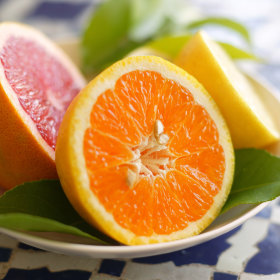
Oranges and olive oil are two of our most common bitter foods. We think of oranges as sweet, but orange cakes incorporate the bitterness of the pith and rind as expressed in bitter orange drinks such as Campari.
In popular wisdom, bitterness is almost always considered negative, but many of our favourite foods are defined by bitterness. Other than oranges and olive oil, think coffee, tea, chocolate and beer.
This disconnect is mainly due to the fact that as children we don’t like bitter foods.
Our five tastes act as a valuable guide in navigating what we should eat.
- Saltiness tells us food contains the salts necessary for fluid regulation in the body.
- Sweetness tells us a food is rich in calorific sugars.
- Sourness indicates a number of positive nutritional benefits, from the presence of beneficial bacteria to vitamin C (humans are one of few animals that don’t produce vitamin C within our bodies).
- Umami tells us that food is likely to be safe, through being cooked or fermented to remove harmful bacteria.
- Bitterness, on the other hand, is a mainly negative taste. It warns us that something we are about to eat (mainly plants) might be poisonous.
Children are more sensitive to the physical characteristics of taste than adults, so as children, we naturally favour sweet foods over bitter ones.
The thing is, the success of humans as a species of omnivores is due to our relatively giant brains helping us adapt to eat whatever is in our surroundings. As plants evolve to have bitter tastes to discourage animals like us from eating them, we use our big human brains to outsmart those brainless plants by learning to like bitterness.
Take coffee, for example. Over decades of observing little clues about coffee not being poisonous – seeing people not die from drinking it, sharing positive social experiences around cups of it – and with a little help from the stimulation and addictiveness of caffeine, we learn to like bitter coffee so much that many of us can’t start a day without it.
If you have problems with your children not eating their vegetables, the scientifically best way to help them through that is to not force them. They’ll learn by watching you eat them and having positive experiences with them.
After all, nobody had to force you to like coffee, did they?
Appears in these collections
- Keep calm and curry on: Good Food’s 50 most popular recipes of 2023
- Simply the zest: The 25 most popular cakes and bakes of 2023
- Hot from the oven: 10 new cake recipes to add to your to-bake list
- All killer, no filler: Good Food’s 50 most popular recipes of 2023 (so far)
- Come what May: The 20 most popular recipes of the month prove chicken (and cake) prevails
The best recipes from Australia's leading chefs straight to your inbox.
Sign upFrom our partners
Similar Recipes

You already love zucchini slice. Adam Liaw explains how to make it even better
- 30 mins - 1 hr
- Adam Liaw

